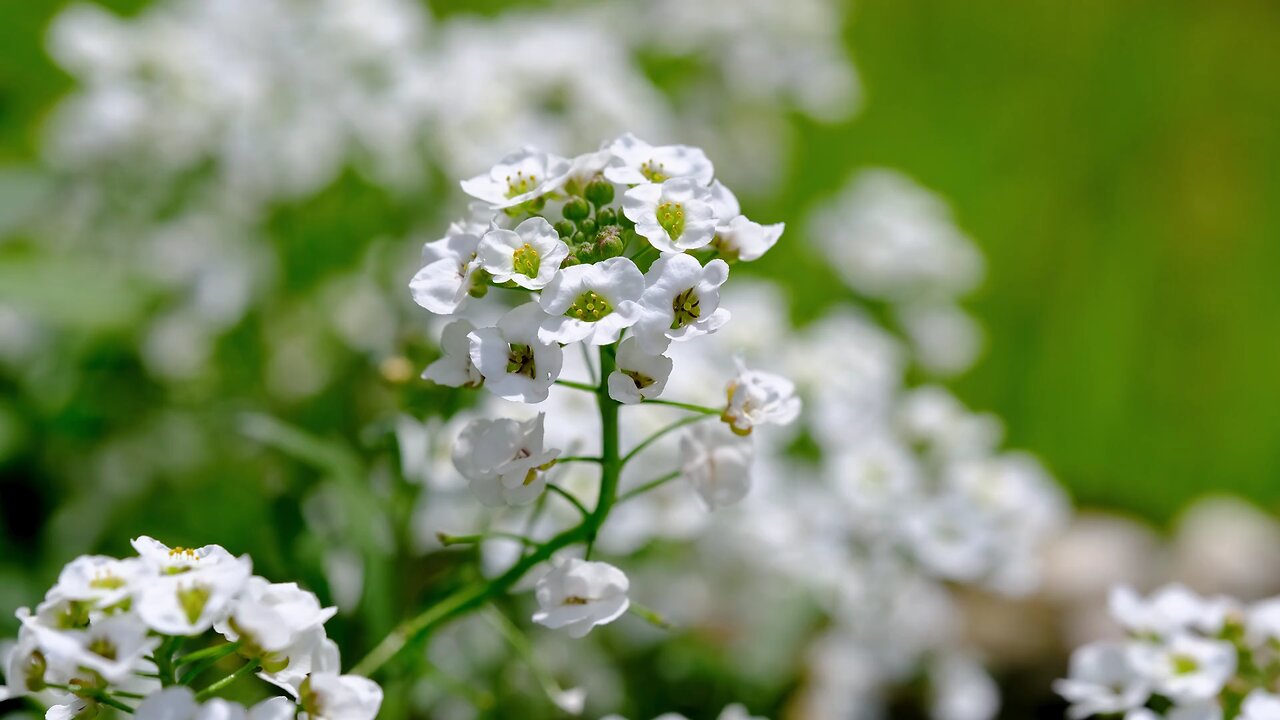Premium Only Content

"The Beauty and Fragrance of Alyssum in Your Garden"
Alyssum, particularly *Lobularia maritima*, is a small, hardy plant prized for its dense clusters of tiny, sweetly fragrant flowers. Here are some detailed aspects of Alyssum:
### **Botanical Characteristics:**
- **Growth Habit:** Alyssum is a low-growing plant, typically reaching 4-8 inches in height with a spread of about 12-24 inches. It has a mounding or trailing habit, making it ideal for borders, ground cover, or hanging baskets.
- **Leaves:** The leaves are small, lance-shaped, and slightly hairy. They are usually gray-green, though they can vary depending on the variety.
- **Flowers:** The flowers are tiny, about 1/4 inch across, and grow in dense clusters. They can be white, pink, lavender, or purple. The blooms have a honey-like fragrance that is particularly strong during the evening or early morning.
### **Cultivation:**
- **Sunlight:** Alyssum thrives in full sun but can tolerate partial shade, especially in hot climates.
- **Soil:** It prefers well-drained, moderately fertile soil but is adaptable to various soil types, including sandy and loamy soils.
- **Watering:** Alyssum is drought-tolerant once established, but it prefers regular watering, especially during dry spells. However, it does not like to sit in waterlogged soil, which can lead to root rot.
- **Fertilization:** A light application of balanced fertilizer in the spring can encourage more vigorous growth and blooms.
- **Pruning:** Deadheading or cutting back spent blooms can promote a second flush of flowers and prevent the plant from becoming leggy.
### **Blooming Period:**
- Alyssum blooms profusely from spring to late fall in temperate climates. In cooler regions, it may bloom continuously from spring until the first frost. In warmer climates, it can bloom almost year-round.
### **Uses in the Garden:**
- **Ground Cover:** Due to its low-growing and spreading habit, Alyssum is often used as a ground cover in flower beds and borders.
- **Companion Planting:** Alyssum is beneficial in vegetable gardens as it attracts pollinators and beneficial insects like hoverflies, which help control aphids.
- **Containers:** It works well in containers, hanging baskets, and window boxes, where it can spill over the edges beautifully.
- **Rock Gardens:** Alyssum’s ability to thrive in poor, rocky soil makes it a great choice for rock gardens.
### **Varieties:**
- **‘Snow Princess’**: Known for its vigorous growth and pure white flowers, it’s a popular choice for hanging baskets and ground cover.
- **‘Easter Bonnet’ Series**: This series offers compact plants with a range of flower colors, including pink, white, and purple.
- **‘Royal Carpet’**: A popular variety with deep purple flowers, ideal for adding vibrant color to garden edges.
### **Pest and Disease Resistance:**
Alyssum is generally pest-resistant but can occasionally suffer from issues like aphids, whiteflies, or root rot if overwatered. Good air circulation and well-drained soil can prevent most problems.
### **Symbolism and Uses:**
- **Symbolism:** In the language of flowers, Alyssum symbolizes worth beyond beauty and is often associated with calmness and emotional tranquility.
- **Uses:** Besides its ornamental uses, Alyssum’s flowers are edible and can be used as a garnish in salads, adding a mild, slightly peppery flavor.
Alyssum is an excellent choice for gardeners seeking a reliable, low-maintenance plant that offers continuous color and fragrance throughout the growing season.
-
 LIVE
LIVE
Dr Disrespect
2 hours ago🔴LIVE - DR DISRESPECT - DELTA FORCE - INTENSE SITUATIONS ONLY!
4,824 watching -
 1:08:33
1:08:33
Winston Marshall
5 hours agoBritain’s R*PE GANGS: How and Why The Media Failed - Patrick Christys
1.49K2 -
 LIVE
LIVE
Professor Nez
1 hour ago🚨BREAKING: Trump SLAMS Sentencing to Judge Merchan's FACE in New York Hush Money Case
396 watching -
 LIVE
LIVE
Barstool Yak
2 hours agoThe Yak with Big Cat & Co. Presented by Rhoback | The Yak 1-10-25
135 watching -
 LIVE
LIVE
The Charlie Kirk Show
1 hour agoThe Lawfare Ends + CA Fire Updates + TikTok's Future| Darvish, Sen. Schmitt, Brown | 1.10.2025
10,020 watching -
 1:03:33
1:03:33
The Dan Bongino Show
3 hours agoDisturbing News On The Lawfare Op Against Trump (Ep. 2398) - 01/10/2025
444K1.79K -
 50:45
50:45
The Rubin Report
20 hours agoBill Maher Shocks Stephen A. Smith with What Liberals Tell Him Behind Closed Doors
28.6K20 -
 LIVE
LIVE
Film Threat
2 hours agoJANUARY CRAP CONTINUES! | Film Threat Livecast
149 watching -
 33:42
33:42
Tudor Dixon
3 hours agoWho's to Blame for the California Wildfires? | The Tudor Dixon Podcast
2.47K1 -

The Big Mig™
18 hours agoGlobal Finance Forum Powered By Genesis Gold Group
3.91K3